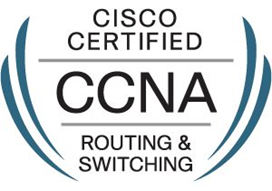

CCNA Routing and Switching

CCNA v-7.02 (New Curriculum)
CCNA Module-1: Introduction to Networks (ITN)
The first module covers the architecture, structure, functions and components of the Internet and other computer networks. Students achieve a basic understanding of how networks operate and how to build simple local area networks (LAN), perform basic configurations for routers and switches, and implement Internet Protocol (IP).
By the end of the course, students will be able to:
- Configure switches and end devices to provide access to local and remote network resources.
- Explain how physical and data link layer protocols support the operation of Ethernet in a switched network.
- Configure routers to enable end-to-end connectivity between remote devices.
- Create IPv4 and IPv6 addressing schemes and verify network connectivity between devices.
- Explain how the upper layers of the OSI model support network applications.
- Configure a small network with security best practices.
- Troubleshoot connectivity in a small network.
Click here for academy admission form and other details
CCNA Module-2: Switching, Routing, and Wireless Essentials (SRWE)
The second module covers the architecture, components, and operations of routers and switches in small networks and introduces wireless local area networks (WLAN) and security concepts. Students learn how to configure and troubleshoot routers and switches for advanced functionality using security best practices and resolve common issues with protocols in both IPv4 and IPv6 networks.
By the end of the course, students will be able to:
- Configure VLANs and Inter-VLAN routing applying security best practices.
- Troubleshoot inter-VLAN routing on Layer 3 devices.
- Configure redundancy on a switched network using STP and EtherChannel.
- Troubleshoot EtherChannel on switched networks.
- Explain how to support available and reliable networks using dynamic addressing and first-hop redundancy protocols.
- Configure dynamic address allocation in IPv6 networks.
- Configure WLANs using a WLC and L2 security best practices.
- Configure switch security to mitigate LAN attacks.
- Configure IPv4 and IPv6 static routing on routers.
Click here for academy admission form and other details
CCNA Module-3: Enterprise Networking, Security, and Automation (ENSA)
The third module describes the architecture, components, operations, and security to scale for large, complex networks, including wide area network (WAN) technologies. The course emphasizes network security concepts and introduces network virtualization and automation. Students learn how to configure, troubleshoot, and secure enterprise network devices and understand how application programming interfaces (API) and configuration management tools enable network automation.
By the end of the course, students will be able to:
- Configure single-area OSPFv2 in both point-to-point and multiaccess networks.
- Explain how to mitigate threats and enhance network security using access control lists and security best practices.
- Implement standard IPv4 ACLs to filter traffic and secure administrative access.
- Configure NAT services on the edge router to provide IPv4 address scalability.
- Explain techniques to provide address scalability and secure remote access for WANs.
- Explain how to optimize, monitor, and troubleshoot scalable network architectures.
- Explain how networking devices implement QoS.
- Implement protocols to manage the network.
- Explain how technologies such as virtualization, software-defined networking, and automation affect evolving networks.
Click here for academy admission form and other details